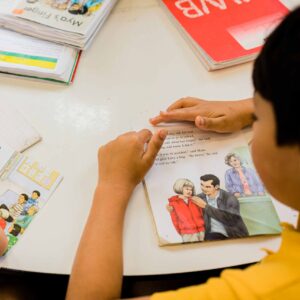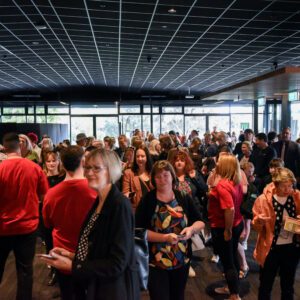The Fairfield Project, administered by the Kukutāruhe Education Trust, is a restoration project with a difference – its vision is to develop, in the Fairfield Community (in Hamilton), an Ecological and Education Centre with a focus on all facets of environmental education and practice aimed at a sustainable future.
The project has developed a set of guiding principles –
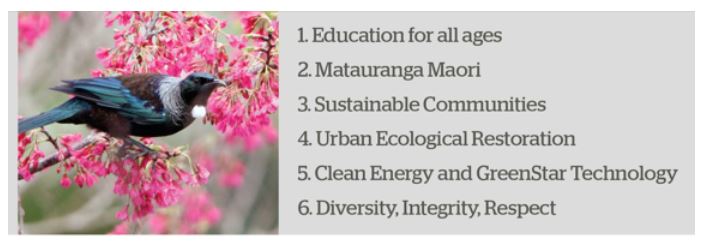
The first guiding principle – education for all ages – encompasses a variety of possibilities – and opportunities to implement it will evolve as the project develops. At present our major contexts for learning are our community gardens and the restoration of the Kukutāruhe Gully. We envisaged the centre will provide access to learning, training and experience and will be used by the community to meet educational needs across a range of contexts.
The first guiding principle – education for all ages –encompasses a variety of possibilities – and opportunities to implement it will evolve as the project develops. At present our major contexts for learning are our community gardens and the restoration of the Kukutāruhe Gully.
We envisaged the centre will provide access to learning, training and experience and will be used by the community to meet educational needs across a range of contexts.
To date we have been working both formally and informally with students from several local schools and ECE centres, implementing curriculum changes and incorporating student experiences around the contexts that our project currently offers.
As educator for this project, I love the opportunities to get students out and exploring the world around them. I am an experienced teacher and professional development facilitator with a passion for ‘doing’ science and environmental education in the outdoors – supporting teachers and students to explore their own environment and to put their science learning into action.
To date we have been working both formally and informally with students from several local schools and ECE centres, implementing curriculum changes and incorporating student experiences around the contexts that our project currently offers. As educator for this project, I love the opportunities to get students out and exploring the world around them. I am an experienced teacher and professional development facilitator with a passion for ‘doing’ science and environmental education in the outdoors – supporting teachers and students to explore their own environment and to put their science learning into action.
The most recent TIMSS report (Caygill, Singh, & Hanlar, 2014) shows that about half of NZ primary school teachers do not feel very well prepared to teach science topics, and many have less confidence teaching science than their international peers. Confidence is important, since a recent ERO report (2011) suggests that science teaching is less effective in classrooms where a lack of confidence in teaching science is a factor.
So – when the opportunity to work with the Science Learning Hub came up, The Fairfield Project w very excited and we decided to begin at the beginning – to work with teachers to build their confidence in a non-threatening context – by offering workshops to fit with the Eco-warrior theme of Primary Science Week 2018.
Confidence is important, since a recent ERO report (2011) suggests that science teaching is less effective in classrooms where a lack of confidence in teaching science is a factor.
So – when the opportunity to work with the Science Learning Hub came up, The Fairfield Project was very excited and we decided to begin at the beginning – to work with teachers to build their confidence in a non-threatening context – by offering workshops to fit with the Eco-warrior theme of Primary Science Week 2018.
The aim was to introduce a range of practical ecology-based activities using everyday materials and focus on building students’ science capabilities, by exploring their own school grounds. It was also important to model an integrated style of teaching and learning, without losing the explicit science learning outcomes, as can often happen (ERO 2011).
Andrea Soanes, Angela Schipper (from the Science Learning Hub) and I co-facilitated the workshops, and the teachers were wonderful to work with.
We started by asking the questions – What makes a good scientist? How can we foster ‘good’ scientific thinking?
We used concept cartoons to elicit ideas. To quote Professor Vic Arcus (University of Waikato) – the most important thing a teacher can do is to “Find activities that foster curiosity!” This statement summed up the sentiment of the teachers present, and expressed a key intent of the workshop.
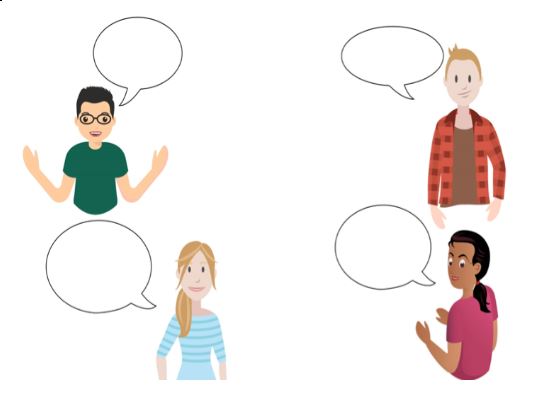
THE PEDAGOGY
A fundamental skill, that all good scientists have, is the ability to make observations. We chose some very simple observation activities, designed to foster curiosity and generate good questions, which could lead to inquiry in science or to other curriculum work.
Many science activities are inherently fun and engaging. Value can be added, improving the science learning, through the use of critical and targeted questioning, both by the teacher using direct or prompting questions or by the students themselves.
Specifically, targeted questioning can encourage students to make connections to prior knowledge, think about things more deeply or widely, and also highlight the science skills and ideas.
THE ACTIVITIES
The activities we chose were simple, easy to carry out and could be done on the school grounds. They were designed as a sequence, but are easy to modify to suit the particular needs of students and programmes.
For any activities, as teachers when we are planning, we ask ourselves questions such as: What is the learning in this activity? What preparation is needed to make this as successful as possible for my students? What prior knowledge or language do my students have or need? What scaffolding might I need to do? How would/could I modify this for my students?
In our workshop, teachers participated in these activities and then we discussed the learning – both for us, and our students.
Activity 1: Blindfold trust walk
Take a partner for a brief walk, blindfolded, and allow them to explore. Then swap over.
Prompting questions for student discussion
What did you hear, smell and feel? How did it feel not to use your eyes? What information was gathered with your other senses that might not have been noticed if you could see?
Food for teacher thought
How will you process the observations? What will you do with the information? What might you do with any descriptive language that is generated?
Activity 2: Collections
Collect at least 5 different types of natural objects.
Sort the items you collected into groups.
Prompting questions for student discussion
How did you decide that something was a natural object? How did you decide which items went into each group? Ie. What criteria and/or tools did you use? What skills did you use to do this task? What prior knowledge did you use?
Food for teacher thought
How would you tailor these questions for your students? How will you support them to identify the skills they use?
Activity 3: Looking at leaves
Separate out all the leaves from the objects you collected outside.
Then choose one leaf each, and observe it very carefully. (You may wish to use a magnifying glass to help with this.)
Prompting questions for student discussion
How did you decide they were all leaves? How many different observations can you make?
Food for teacher thought
How many of the observations are actually inferences?
What descriptive words are the students using, and how can you make use of this language? Are the students using similes, or making measurements? Is any prior knowledge showing through?
Activity 4: Scavenger hunt
Taking the Scavenger hunt sheet with you, find evidence of something that fits each of the boxes.
Prompting questions for student discussion
What does evidence mean? Was it possible to find all the evidence? What does the evidence tell us about the environment we were in?
Food for teacher thought
What discussions might need to be had with your students before they go out? eg. What is evidence? What words need to be explained? How do we use evidence to make decisions and conclusions? What is the difference between evidence and information?
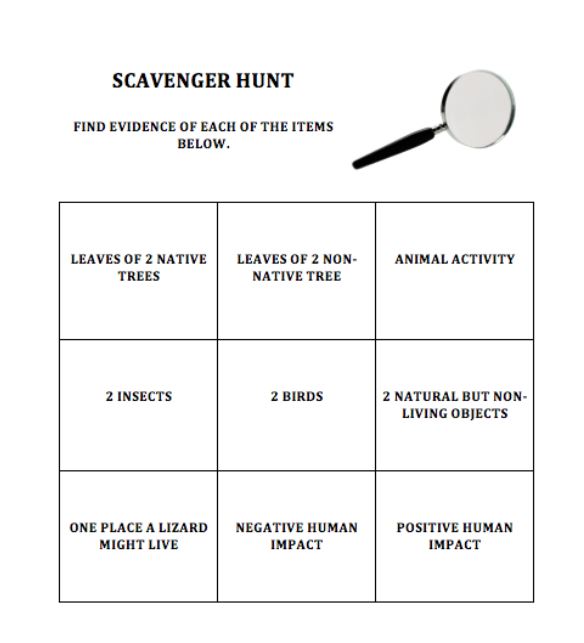
THE SCIENCE
All scientific classification is based on making choices. For example –all organisms belong to one of 5 different groups. All groups have different characteristics and criteria are used to make decisions about living things.
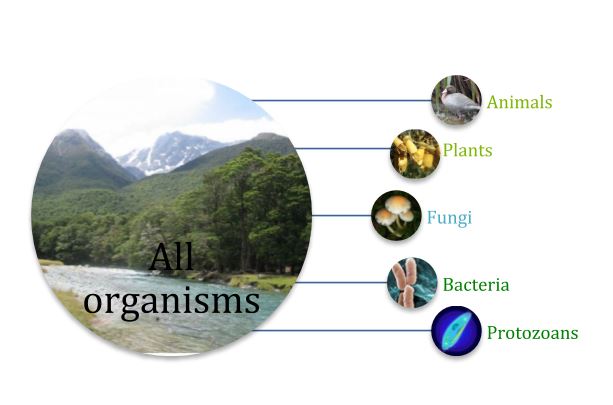
Gathering observational data is a key way of finding out about the world.
Once data is processed and analysed, or interpreted in some way, it becomes information that may be used for building our knowledge or understanding.
It may also constitute evidence that can be used to make conclusions, support decisions, or lead to further questions or investigation.
‘What sets scientific explanations apart from other ways of explaining the world is their reliance on evidence and their ability to evolve as new evidence comes to light.’ (TKI)
THE CURRICULUM
There are many ways to connect the above activities to the Science curriculum. The most apparent connections are with the Living World’s strands of Ecology and Life Processes. Many of the discussions may go off at a tangent eg. Connecting to learning about the senses in Activity 1. Observation is fundamental to success in science across all the strands.
Focusing on the Nature of Science allows us to build an understanding of the progress students are making in developing their science skills, and their understanding of how science works. The Science Capabilities have been designed to make aspects of the Nature of Science more explicit. The two capabilities particularly relevant to these activities are:
Gather & interpret data
Learners make careful observations and differentiate between observation and inference. Students begin to ask themselves questions such as:
- What did we see? (observation)
- What might that mean? (inference)
- How could we explain what we see?
Use evidence
Learners support their ideas with evidence and look for evidence supporting others’ explanations. Students begin to ask themselves questions such as:
- How do you know that?
- What makes you think so?
- How could you check that?
Across the curriculum connections are easy to make. Some of these include:
Language use: both oral and written, listening, reading and writing.
Numeracy: Counting, grouping and measuring.
Digital technologies: Processing information, computational thinking.
USEFUL RESOURCES
The Science Learning Hub has plenty of resources supporting teachers and students with building understandings and skills about observation – including Observation – learning to see and Developing observation skills in younger students. Simply put observation in as a search term. There is also a lot of material on the Hub looking at classification, including activities such as Living or non-living and Native plant leaves – a DIY classification system.
NZCER have published a range of contextual questions designed to prompt thinking: these are the on the ARBs and in the Thinking with evidence test papers (for Years 7&8).
The Department of Conservation has published a new set of resources for primary schools focusing on different aspects of environmental exploration. They include some great activities to do with students outside the classroom and they outline curriculum links and other useful resources.
The Connected series and School Journals have a range of great stories that can be used to foster literacy connections and deepen science understandings. They are available in all primary schools, but can also be searched for through Journal Surf. One title with a variety of articles about observation, data and the natural world is I spy… (Connected No.2 2013).

